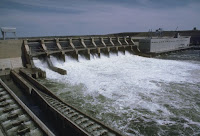A proposal from Rep. Mike Simpson, R-Idaho, regarding the future of four dams along the Lower Snake River needs robust debate and thoughtful consideration. It does not need churlish infighting designed to distract from the issues.
Rep. Jaime Herrera Beutler, R-Battle Ground, is wise not to
be drawn into the internecine squabble that has erupted. Herrera Beutler has
been vocal in her opposition to the plan and articulate in her reasoning why
the dams should remain; she need not distract from those topics, as some of her
colleagues have done.
The other three Republican representatives from the Pacific
Northwest — Washington’s Cathy McMorris Rodgers and Dan Newhouse, and Oregon’s
Cliff Bentz — last week publicized a letter they sent to Simpson criticizing
his “secret” discussions with Oregon Gov. Kate Brown.
Simpson posted a response that included, “How is that
secret? My staff has had discussions with nearly every governor, member of
Congress, and U.S. senator in the Columbia Basin on this proposal.”
Simpson has worked on the proposal for three years,
conducting some 300 meetings. “I expected pushback when this all started,” he
said. “What I did not expect was colleagues with whom I have worked for a
number of years on a number of issues to question my integrity, to insinuate I
have lied about my motivation and in fact have nefarious intentions — to —
what? Sabotage the economy of my own state?”
Concerns about unsavory intentions should be dismissed so
Congress can get to the business of considering the proposal. Because there is
much to discuss.
The plan, dubbed the “Columbia Basin Initiative,” would
breach four dams along the river — partly out of a desire to improve salmon
recovery throughout the region. Most of the proposed $33.5 billion cost would
go to replacing the electricity the dams generate and the barging capacity they
provide, along with irrigation that is necessary for the agriculture industry.
Herrera Beutler has opposed the proposal, signing on to a
statement that says, “The clean, renewable power generated by the dams along
the Columbia and Snake rivers supplies half of the Pacific Northwest’s energy
and is critical for a reliable power grid.”
That is a reasonable position that deserves consideration.
So does Simpson’s complex proposal.
Any potential plan must include protections for fish and
tribal interests, clean-energy solutions, flood control and farm-to-market
provisions for farmers without soaking taxpayers, and Simpson has boldly
attempted to strike that balance.
Environmental groups quickly decried the proposal, partly
out of concern that it calls for a 35-year moratorium on lawsuits related to
the dams. The plan also would suspend some environmental regulations for other
dams throughout the Columbia Basin. But those same conservation groups long
have called for dam removal, saying it is essential for the survival of the
region’s salmon — and, by extension, orcas. That provides hope that some middle
ground can be found.
Any proposal that has some aspects supported by all
stakeholders and other aspects those stakeholders oppose is a good starting
point. It should generate debate rather than claims of villainous wrongdoing.
But such is the current state of politics, where accusations take the place of
discussions and proposals infrequently are considered on their actual merits.
Diminishing salmon runs dictate that thoughtful action be
taken. Simpson’s proposal provides a framework for that thinking to begin.
